🥢 The Ultimate Seoul Market Guide – Discovering Where Locals Really Eat in Seoul’s Traditional Markets
🧭 Market Comparison Table (Updated 2025 Edition)
| Market | Vibe | Local Presence | Must-Try Foods | Price | Verdict |
|---|---|---|---|---|---|
| Gwangjang | Traditional + Tourist | ★☆☆☆☆ | Yukhoe, Bindaetteok | High | ⚠️ For first-timers only |
| Namdaemun | Everyday Market | ★★★★☆ | Kalguksu, Hotteok | Low | 👍 Recommended |
| Myeongdong Night Market | Trendy Tourist | ★☆☆☆☆ | Fusion snacks | High | ❌ Skip |
| Mangwon | Local Neighborhood | ★★★★★ | Donuts, Gimbap, Fish cakes | Very Low | 💯 Top Local Pick |
| Tongin | Experience-based | ★★★☆☆ | Dosirak Lunchbox | Mid | 🌟 Fun for visitors |
| Noryangjin Fish Market | Seafood Market | ★★★★☆ | Sashimi, Grilled shellfish | Varies | 🐟 Fresh & Unique |
| Dongdaemun Market | Fashion & Textile Hub | ★★★☆☆ | Fabrics, Designer clothing | Mid to High | 👗 Shop Till Midnight |
| Garak Market | Wholesale Food Market | ★★★☆☆ | Fresh seafood & produce | Low | 🥦 For Serious Foodies |
| Majang Meat Market | Meat Specialty Market | ★★★☆☆ | Korean beef, Barbecue cuts | Mid | 🥩 C |
1️⃣ Gwangjang Market (Jongno-gu) – Seoul Market Guide
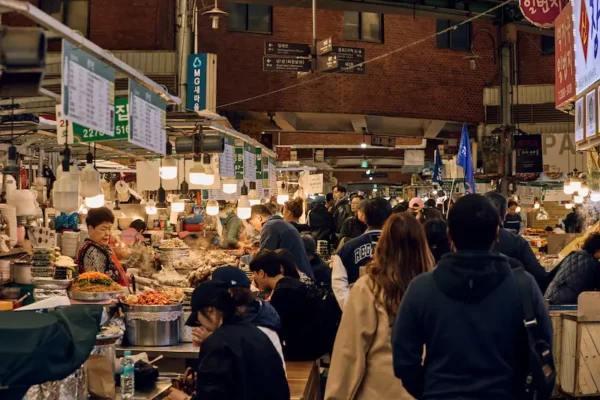
📍 Address: 88 Changgyeonggung-ro, Jongno-gu, Seoul
🕓 Hours: 9 AM – 10 PM (some food stalls stay open past midnight) / some shops closed Mondays
🍽️ Specialties: Yukhoe (beef tartare), Bindaetteok (mung-bean pancake), Mayak Gimbap, Bibim Guksu
✔️ Pros:
The most famous “traditional market” in Seoul, often featured in YouTube and Netflix.
Offers classic street foods like yukhoe, bindaetteok, tteokbokki, mini gimbap rolls.
Buzzing alleys and old-style food stalls evoke vintage Korean charm.
Many vendors accept credit cards; great for photos and video content.
⚠️ Cons:
Reports of overpricing and tourist-targeted scams — some stalls may overcharge non-locals or serve lower quality food.
Extremely crowded at lunch and dinner hours — seating is hard to find.Feels like a “performance market” for influencers more than everyday dining.
Many visitors say the food is too oily or too sweet.
💬 Traveler insight:
“It’s a tourist trap — fine to visit once for the vibe, but not for authentic flavor.”
Official website: 광장시장 – 대한민국 대표재래시장(English pages available)
🏮 Explore Bukchon & Gwangjang — Seoul’s Timeless Duo
Discover the beauty of hanok alleys and the flavors of Gwangjang Market
with this [Bukchon Hanok Village & Gwangjang Market Half-day Guided Tour]
2️⃣ Namdaemun Market (Jung-gu)
📍 Address: 21 Namdaemun-sijang 4-gil, Jung-gu, Seoul
🕓 Hours: 8 AM – 9 PM (food alleys often open 6 AM – 8 PM) / partially closed Sundays
🍽️ Specialties: Galchi-jorim (braised hairtail fish), Kalguksu, Hotteok, Tteok-galbi, Gukbap
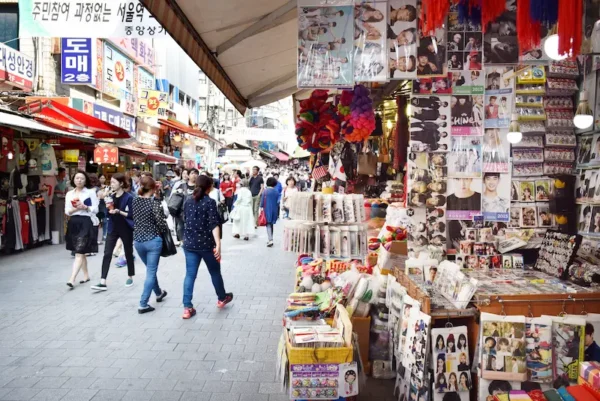
✔️ Pros: More local vendors and office workers than tourists.
Feels like a daily-life market: clothing, cookware, snacks, produce.
The Namdaemun Kalguksu Alley is beloved by locals for hearty noodles.
Honest prices and generous portions.
⚠️ Cons:
More of a general market than street-food-focused.
Some sections are old and narrow.
Official website: namdaemunmarket.co.kr
—
### 🍜 Experience Namdaemun Like a Local
Join the [Namdaemun Market Food Street Half-day Guided Tour]
and taste Seoul’s real street flavors — from kalguksu and hotteok
to hidden stalls only locals know.-
3️⃣ Myeongdong Night Market (Jung-gu)
📍 Address: Along Myeongdong 8-gil, Jung-gu, Seoul
🕓 Hours: 4 PM – 11 PM (daily, weather-dependent)
🍽️ Specialties: Fusion desserts, skewers, Japanese okonomiyaki, Taiwanese snacks, bubble tea
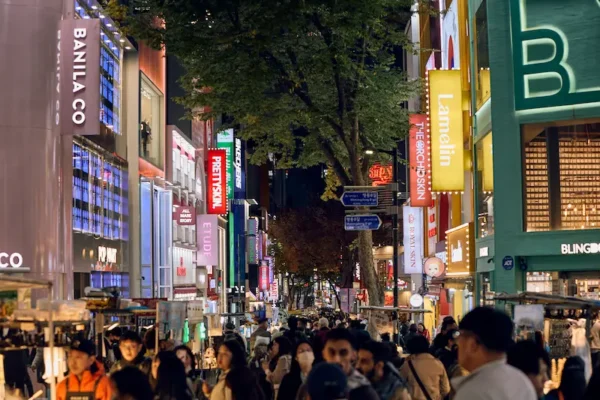
✔️ Pros:
Trendy night-only food scene right in the heart of Seoul’s shopping district.
Can easily combine with visits to Myeongdong Cathedral, department stores, beauty shops.
Lots of international flavors — accessible for non-Korean eaters.
⚠️ Cons:
Not an authentic “traditional market” — mostly temporary stalls for tourists.
Prices tend to be high and food quality inconsistent.
More instagrammable than genuinely Korean in culinary depth.
4️⃣ Mangwon Market (Mapo-gu) – Seoul Market Guide
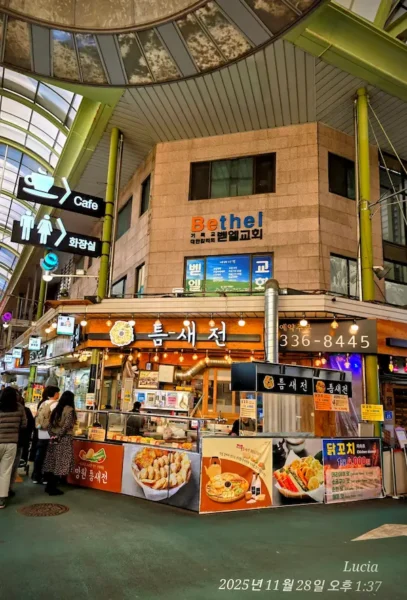
📍 Address: 14 Mangwon-ro 8-gil, Mapo-gu, Seoul
🕓 Hours: 10 AM – 9 PM (most shops close by 8 PM) / many shops closed Mondays
🍽️ Specialties: Donuts, fish cakes, gimbap, noodle soups, soondae, deep-fried snacks
✔️ Pros:
Locals’ favorite — residents from Hongdae & Hapjeong frequent it.
Warm, clean, authentic environment sans tourist overload.
Homemade donuts, fish cakes, tteokbokki, gimbap are affordable & tasty.
Many shops accept cards.
💡 Why visit: mangwonkmarket.en
“SNS trends don’t matter here — it’s about flavor and friendliness.”
Perfect for sampling everyday Seoul life at friendly prices.
5️⃣ Tongin Market (Jongno-gu) – Seoul Market Guide
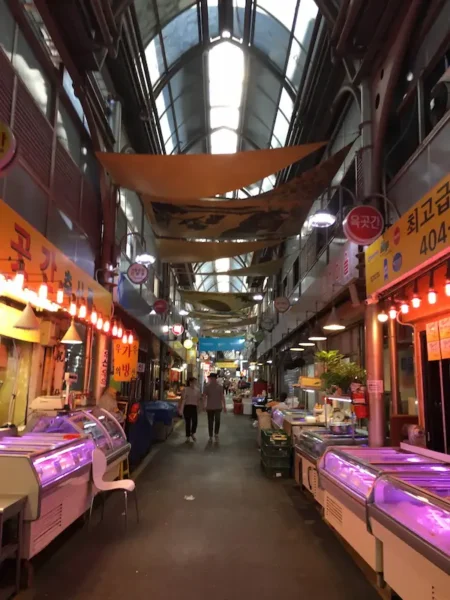
📍 Address: 18 Jahamun-ro 15-gil, Jongno-gu, Seoul
🕓 Hours: 11 AM – 5 PM (“Dosirak Café” hours) / closed Mondays
🍽️ Specialties: Lunch-box (Dosirak) café using coin tokens, Korean side dishes, tteokbokki, jeon
✔️ Pros:
Famous for the Dosirak Café: exchange brass coins for side dishes to fill your tray.
Clean, mild food — good for families or cautious eaters.
Located near Gyeongbokgung Palace and the presidential residence — great for a morning visit.
💡 Why visit:
Small but charming — like a “mini Korean buffet.”
Recently revitalized with young entrepreneurs and creative food stalls.
6️⃣ Noryangjin Fish Market – Seoul Market Guide
📍 Noryangjin Fish Market: 674 Nodeul-ro, Dongjak-gu, Seoul (24 hours, some stalls closed Sundays)
✔️ Pros:
- buy fresh seafood downstairs, have it sliced into sashimi upstairs.
💡 Why visit: Noryangjin Fisheries Wholesale Market : Homapage
Deeply local and off the usual tourist path.
Noryangjin is Seoul’s seafood icon.
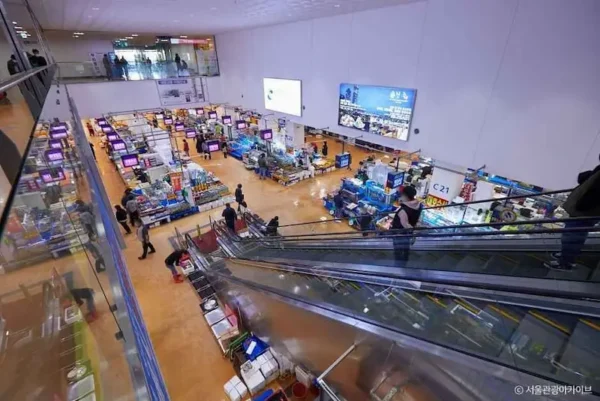
7️⃣ Dongdaemun Market (Jung-gu) – Seoul Market Guide
📍 Address: 18-194 Euljiro 6-ga, Jung-gu, Seoul, South Korea
📞 Phone: +82-2-2236-9135
🕓 Hours:
Wholesale malls: 9 PM – next morning (closed Saturdays)
Retail malls: 10:30 AM – 5 AM (Migliore & Cerestar closed Mondays, Goodmorning City & Hello apM closed Tuesdays)
💳 Payment: Credit cards accepted (cash often gets extra discounts)
💰 Price Range: Affordable — varies by store and brand
🍽️ Specialties:
Fashion, fabrics, leather goods, women’s wear, children’s clothes
✔️ Pros:
Seoul’s biggest fashion district, home to over 10 massive malls and hundreds of independent boutiques.
Great for those seeking unique Korean designer pieces at wholesale prices.
Both retail and wholesale options — night markets for late-night shoppers.
⚠️ Cons:
Not primarily a food market — more of a fashion and textile hub.
Can be overwhelming due to its size and crowds.
Some areas look industrial and chaotic, especially at night.
💡 Why visit: DONGDAEMUN SHOPPING COMPLEX
Perfect for fashion lovers and K-style enthusiasts who want to see where many local brands and designers start their journey.
🛍️ Shop Smart in Seoul’s Fashion District — Dongdaemun Super PASS (Klook Exclusive)
Get instant discounts & freebies at Doota Mall, Hyundai Outlets, and DDP!
Valid until Dec 31, 2025 — all for just US$1.25.
✨ Grab your Super PASS and shop like a local in Seoul’s biggest fashion hub.
8️⃣ Garak Market (Songpa-gu) – Seoul Market Guide
📍 Address: 932 Yangjae-daero, Songpa-gu, Seoul, South Korea
📞 Phone: +82-2-408-7001
🌐 Website: www.garak.co.kr (Korean only)
🕓 Hours:
Vegetable auction: 6 PM – 9 PM
Seafood auction: 1 AM – 3:30 AM
Closed: Sundays, New Year’s Day, Seollal & Chuseok holidays (for agriculture & fishery sections)
🍽️ Specialties:
Fresh produce, seafood, meat, dried foods, fruits, vegetables
✔️ Pros:
Established in 1985 as Korea’s first public wholesale market.
Offers the freshest ingredients at significantly lower prices than supermarkets.
You can watch live auctions for seafood or vegetables — a rare glimpse of the real Korean food supply chain.
A few sections include small eateries serving hearty local meals to market workers.
⚠️ Cons:
The market is huge — navigation can be confusing for first-time visitors.
Early-morning auctions mean it’s not ideal for casual tourists.
Limited English signage.
💡 Why visit:
A great stop for foodies or photographers interested in Seoul’s food distribution culture and raw, behind-the-scenes market life.
9️⃣ Majang Meat Market (Seongdong-gu) – Seoul Market Guide
📍 Address: Majang-dong, Seongdong-gu, Seoul, South Korea
🕓 Hours: 8 AM – 10 PM
🍽️ Specialties: Korean beef (Hanwoo), pork belly, steak cuts, beef tartare
✔️ Pros:
The largest meat market in Korea, supplying fresh cuts from both domestic and international sources.
Known for high-quality beef at up to 30% cheaper than supermarket prices.
Dozens of small restaurants around the market grill meat on the spot for you — “Buy downstairs, eat upstairs.”
A true K-meat lover’s paradise — from raw to grilled, it’s all here.
⚠️ Cons:
Very busy, noisy, and sometimes chaotic with scooters and trucks moving through narrow alleys.
Hygiene standards can feel rustic compared to supermarkets.
Strong meat smell everywhere (expected but intense).
💡 Why visit:
If you love Korean barbecue, this is the ultimate local experience — raw, authentic, and full of energy.
🥢 Morning — Tongin Market (Jongno-gu)
Begin your day with the coin-lunch box experience near Gyeongbokgung Palace.
Exchange brass coins for side dishes, fill your own tray, and enjoy a homemade-style brunch surrounded by locals.
🍩 Afternoon — Mangwon Market (Mapo-gu)
Head west to Mapo for a relaxing snack walk.
Try the famous donuts, gimbap, croquettes, and tteokbokki from family-run stalls — a favorite among Hongdae locals.
Grab a coffee nearby to experience Seoul’s cozy neighborhood vibe.
🐟 Evening — Noryangjin Fish Market (Dongjak-gu)
Wrap up the day at the legendary seafood hub.
Choose your fish downstairs, then head upstairs where restaurants prepare it sashimi-style or grilled.
It’s the most authentic way to end a Seoul food adventure by the Han River.
💡 Optional Add-Ons:
Gwangjang Market for sightseeing and iconic atmosphere.
Dongdaemun Market for late-night shopping and vibrant city lights.
Garak Market to witness the wholesale food auctions (midnight–dawn).
Majang Meat Market for premium Korean beef barbecue at local prices.
💬 Overall Takeaways – Seoul Market Guide
Gwangjang → Best for sightseeing and atmosphere.
Tongin & Mangwon → Best for flavor, friendliness, and local connection.
Namdaemun → The most authentic daily-life market in central Seoul.
Myeongdong → Fun to visit once, but mainly a tourist zone.
Noryangjin, Garak & Majang → Perfect for true food lovers who want to see where locals really shop and eat.
Dongdaemun → For night owls and fashion hunters — a market that never sleeps.
🪶 Final Note:
Seoul’s traditional markets are evolving — blending heritage, youth culture, and everyday life.
What once felt old and chaotic is now vibrant, organized, and full of stories.
Whether you’re chasing flavors, photos, or people, these markets reveal the true rhythm of Seoul — one bite at a time.
Planning to explore beyond Seoul? You’ll be surprised how good the food is at Korea’s highway rest stops — from spicy stews to local specialties.
Read more: Korean Rest Area Food Guide
✨ Suggested Experiences
If you’ve explored Seoul’s markets and still crave more —
why not take it one step further?
🥢 Try a Seoul Traditional Market Walking Tour & Korean Food Cooking Class
to see how locals shop and cook — all in one day!
It’s the perfect follow-up after visiting Gwangjang or Tongin Market —
a deeper dive into Seoul’s real culinary life. 🍲